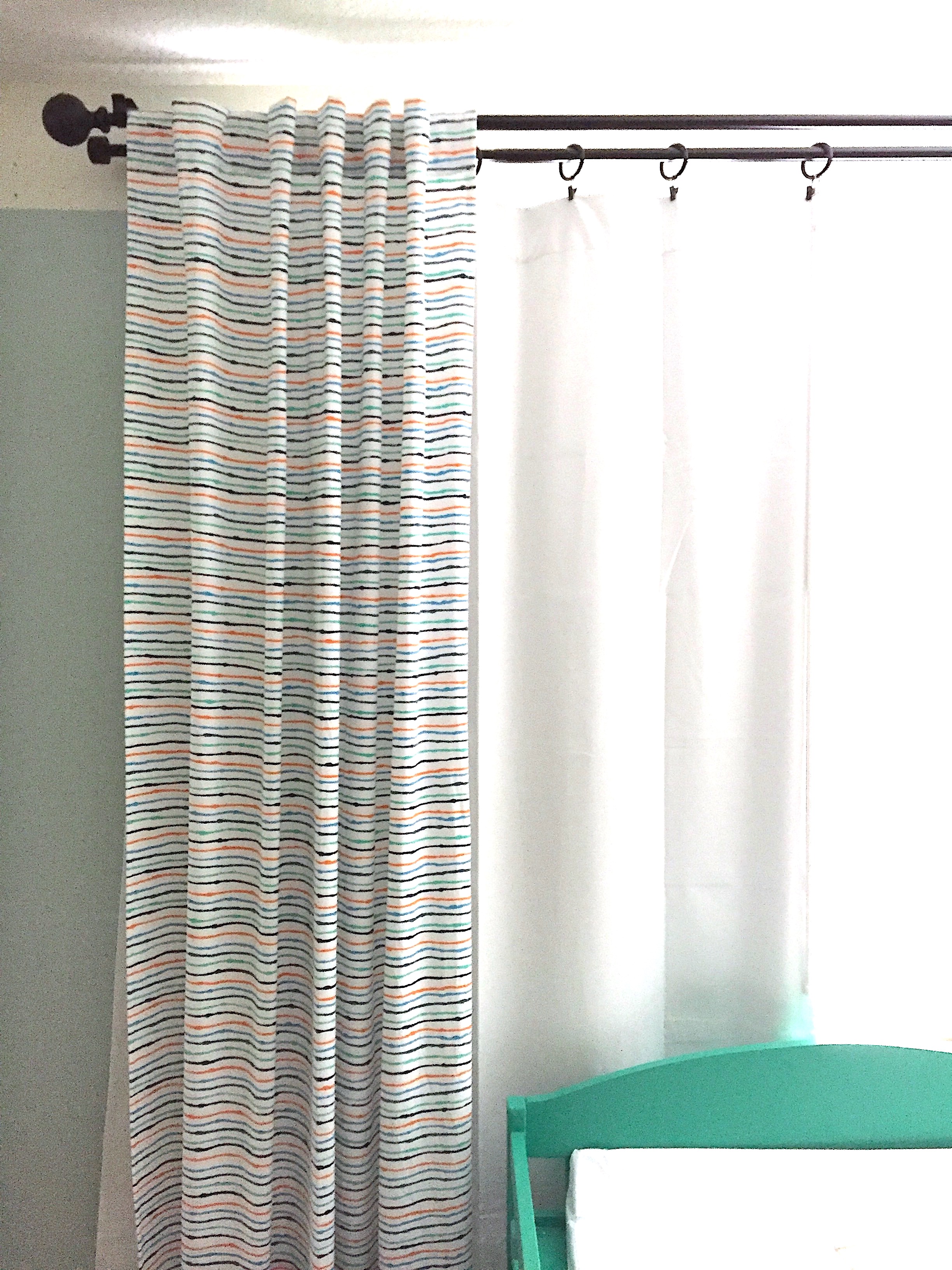How to Layer and Control Light in Your Nursery
/What pops into your head when you think about controlling light in your nursery? Finding a beautiful chandelier to hang above, or a cool industrial table lamp? As fun as those items are to research, don't forget about the utilitarian needs of lighting for you and your baby in the nursery. If you think about it, sometimes the lack of light is just as important. Confused? Don't be! Here's how I layered the lighting in my nursery from the windows to the lamps.
The first thing I see when I walk into my son's nursery is the window wall. I knew I wanted the window treatments to add color and personality, but I also knew they had to function properly for a baby's nursery. As you'll soon find out, that means room darkening options for nap time.
Eeesh- I apologize for the poor photo quality while shooting into sunlight...
I found these colorful curtain panels from The Land of Nod (which sadly is no longer around). They added just enough color without competing with the bold, jungle green changing table. Since they are intended for decorative purposes, I also ordered a pair of room darkening panels to block out the daylight.
Yes, even though I have faux wood blinds in the window, I still needed to layer an additional window treatment. While blinds create privacy and provide a good amount of light control, it is impossible to block out the light that leaks through the router (string) holes and in between the slats of the blinds.
When you use a functioning curtain with a stationary panel, it's best to use a double rod. I found this set at IKEA. Hang your functioning curtains on the rod closest to your wall. I recommend using rings for the functioning treatment to preserve your blackout curtains. Because the material is heavy, it's best not to put extra strain on them. They are also a little pricey, but totally worth it to help your baby nap! It will be much easier to operate several times a day: Morning wake up, nap 1, maybe nap 2, and bedtime.
There are decorative blackout curtains available as well. I just wasn't able to find them for my design. The plus side to my double treatment solution, is that I always get to admire the colorful pattern of my stationary panels because they never get pushed to the sides. Plus, I can also control how much privacy I desire with the existing horizontal blinds.
Another way to use decorative, but stationary panels is to install blackout shades. A roller shade or honeycomb-shade style are most popular, and can be ordered with cordless options to be extra safe around your little ones (and pets!).
I'd like to clarify that while the product is described as "blackout" curtains, shades, or liners, the effect is usually "room-darkening". That is why I like to be cautious with the term "blackout" because very rarely can you truly block out all the light in a room. Custom window treatments can come very close, but nothing is perfect. I prefer to provide my clients with realistic expectations!
Let's move on to our next layer of light- artificial light. Ambient light and task light are two of the three main types of lighting in a room.. When it's night time, and the window treatments are closed for privacy, we need to light the nursery to get our babies dressed for bed, and to avoid tripping over toys, right? This is where layering different light fixtures come into play.
My nursery does not have any electrical wiring in the ceiling. To provide a general, ambient light I found this white lamp at IKEA. I was able to personalize the style with the mix-and-match options. I decided to stay with clean-lines in white because I already have a lot of color in my nursery. The white shade keeps the light bright, and the dimmer control wand under the shade allows easy flexibility when I'm sitting in the nursery chair. I can start reading to Toddler S with bright light, and start to dim the lights in preparation for pajamas. It provides a nice visual cue for bedtime.
Did you notice that the floor lamp base has a shelf? At first I was like, "Ewww..." Then I noticed it's special feature. For all you techies out there, you can wirelessly charge your device, or plug in your USB cord below. That could be convenient when you end up holding your baby for an hour, waiting for them to fall asleep. Your phone battery can only last so long watching Netflix on your phone- Lol.
I thought it might be overkill because I have a side table on the other side of our nursery chair, but it's worked out well. Depending which arm the baby falls asleep in, I can easily set down the empty baby bottle.
The final layer of light in my nursery is this small table lamp from (You guessed it!) IKEA. This little mushroom lamp casts a soft night light in the room. I used this light during nighttime bottle-feeds, and now Toddler S likes to turn it on himself for bedtime stories. The table lamp sits on the bookcase adjacent to his crib. Toddler S can turn it on and off while he's playing in his crib or ready to fall asleep. I turn off the primary, ambient light from the floor lamp, but he can use this lamp to play a bit longer in his crib. For that reason I feel it may qualify as a task lighting? Hmmm.... And the funny thing is, I didn't even know the button switch was also a dimmer. My toddler showed me!
I hope this provides a comprehensive and methodical way to look at the lighting needs in your nursery. Start with your natural day light from the window treatments. Decide how much privacy you need first, and then layer as needed. Maybe you like a minimal style, and all you need is a blackout shade. Or if you prefer a softer, or more finished look, you maybe prefer a double treatment. Then look at your artificial light with lamp. Make sure you have a a general light across the room, and then use task lighting as needed. Maybe have a soft light near the changing table for nighttime diaper changes, or a night light to play a few extra minute before falling asleep, like me.
Speaking of which, it's about time to get ready for nap time. HOORAY.










